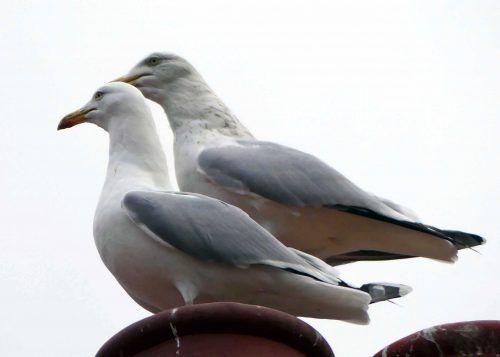Length 55-67cm; Wingspan 130-158cm
The Herring Gull is one of the commonest gulls of Northern European coasts, bigger than a Common Gull it has rather fierce-looking pale eyes with a yellow iris and pink legs and feet.

A very noisy bird it makes a variety of squealing notes, sometimes sounding like it may be chuckling and also producing some quite dog-like yelping and ‘barking’ sounds.
There are 40% less herring gulls now than there were in 1970 and they have now been accorded RED STATUS ; the highest conservation priority, as its numbers have declined dramatically in its former haunts, disappearing completely from some areas.
Gulls, like all UK wild bird species, are protected under the Wildlife and Countryside Act 1981. This makes it a criminal offence to kill, injure or take a gull; or to take, damage or destroy its nest whilst the nest is in use or being built. It is also a criminal offence to take or destroy their eggs.
The European Herring Gull is an increasingly common roof-nesting bird in urban areas of the UK. The Clean Air Act of 1956 forbade the burning of refuse at landfill sites, providing the European Herring Gull with a regular and plentiful source of food. As a direct result of this, European Herring Gull populations in Britain sky-rocketed. Faced with a lack of space at their traditional colonies, the gulls ventured inland in search of new breeding grounds. Dwindling fish stocks in the seas around Britain may also have been a significant factor in the gulls’ move inland.
The gulls are found all year round in the streets and gardens of Britain, due to the presence of street lighting, (which allows the gulls to forage at night), discarded food in streets, food waste contained in easy-to-tear plastic bin bags, food intentionally left out for other birds (or the gulls themselves), the relative lack of predators and readily-available, convenient, warm and undisturbed rooftop nesting space in towns and cities. Particularly large urban gull colonies (composed primarily of European Herring Gulls and Lesser Black-backed gulls are now present in the cities of Cardiff, Bristol, Gloucester and Aberdeen to name but a few.
The survival rate for urban gulls is much higher than their counterparts in coastal areas, with an annual adult mortality rate of less than 5%. It is also common for each European Herring Gull pair to successfully rear three chicks per year. This, when combined with the long-lived nature of European Herring Gulls, has resulted in a massive increase in numbers over a relatively short period of time and has brought the species into conflict with humans.
Once familiar with humans, urban European Herring Gulls show little hesitation in swooping down to steal food from the hands of humans. During the breeding season, the gulls will also aggressively ‘dive bomb’ and attempt to strike with claws and wings (sometimes spraying faeces or vomit at the same time) at humans that they perceive to be a threat to their eggs and chicks — often innocent passers-by or residents of the buildings on which they have constructed their nests. Large amounts of gull excrement deposited on property and the noise from courting pairs and begging chicks in the summer months is also considered to be a nuisance by humans living alongside the European Herring Gull. Non-lethal attempts to deter the gulls from nesting in urban areas have been largely unsuccessful. The European Herring Gull is intelligent and will completely ignore most ‘bird-scaring’ technology after determining that it poses no threat. Rooftop spikes, tensioned wires, netting and similar are also generally ineffective against this species, as it has large, wide feet with thick, leathery skin which affords the seagull excellent weight distribution and protection from sharp objects (the bird may simply balance itself on top of these obstacles with little apparent concern).

A herring gull nest built on a flat roof
If nests are removed and eggs are taken, broken, or oiled, the gulls will simply rebuild and/or re-lay, or choose another nest site in the same area and start again.



